15 Health Benefits of Kurmasana & How to Do It?
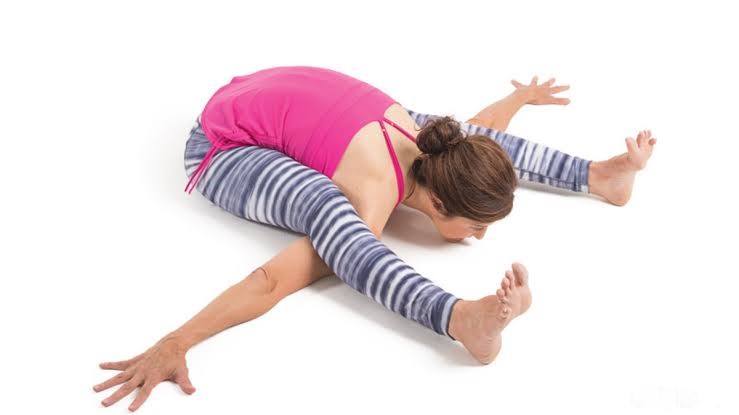
Kurmasana, or the Tortoise Pose, is known for invoking relaxation. So, if you have a tiring day, you can perform this posture in the evening to relax your mind and body. Moreover, unlike many other yoga postures, Kurmasana need not require any equipment. You only need a yoga mat or a carpeted floor to perform this posture.
So, if you want to add this asana to your workout, read this blog. It will guide you about the benefits of Kurmasana, how to perform it and more!

Table of Contents

What is Kurmasana?
“Kurma” in Sanskrit stands for tortoise; that is where it got its name. The Kurmasana is considered a posture that can connect your inner self with the spiritual ones. It enhances the flexibility of the back, hips, neck and shoulders. Furthermore, it also withdraws distractions and keeps your nerves calm.
The Tortoise Pose is beneficial for certain muscles, like the lower and upper back, core abs, biceps and triceps, hamstrings, hips, pelvis, neck and quadriceps. So, if you include this posture with other asanas that focus on the same muscles, you can extract more health benefits.
How to Perform Kurmasana (Tortoise Pose)?
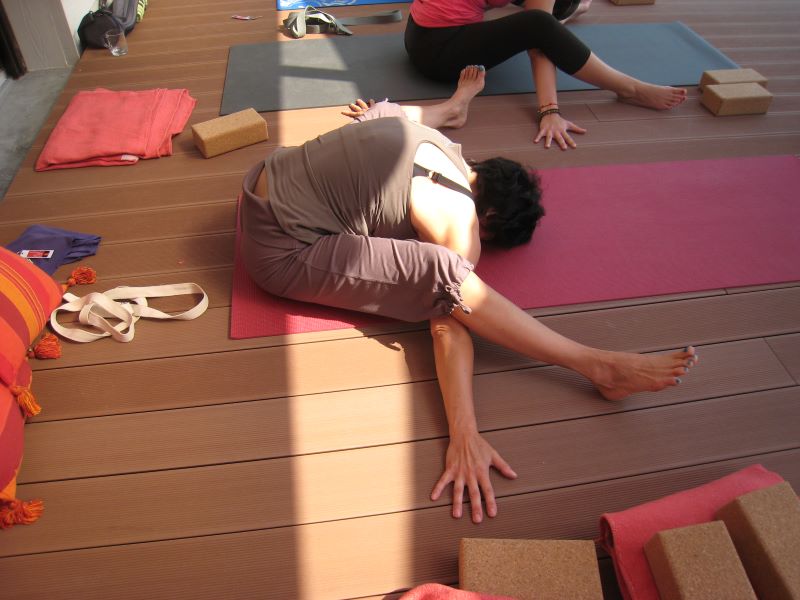
The Tortoise Pose involves extreme stretching, and it engages your whole body as well as your mind. Here is a step-by-step guideline for you to follow:
Step 1: Sit with your back upright and legs spread in front of you.
Step 2: Keep your hands on the floor, close to your hips.
Step 3: With deep breaths, press your thighs on the floor and raise your chest.
Step 4: Now spread your legs away and stretch the toes to point upwards.
Step 5: Inhale and raise your arms.
Step 6: As you exhale slowly, bend your body to the floor and place your hands below the knees.
Step 7: Stretch your hands outwards as much as you can.
Step 8: Along with breathing, touch your chin to the floor.
Step 9: Make sure to fix your gaze upfront and hold this posture.
Step 10: Slowly return to the starting position. You can repeat the same after a while.
15 Health Benefits of Kurmasana
Tortoise Pose is a deep stretching exercise. So, those who want to build flexibility can include this posture with their regular workout sequence. In addition, this is a good pose to regularise breathing.
Some advantages of Kurmasana include the following:
1. Improves Functioning of the Respiratory System
While doing this asana, the muscles in the upper torso contract, and it makes the diaphragm, chest and lungs press downwards. This contraction not just improves the flexibility of these muscles but also improves the functioning of the respiratory organs.
2. Elongates Spine
When you perform the Kurmasana, your body is bent forwards; consequently, you stretch your spine. Thus, it elongates the spinal cord and also makes sure the blood circulation is smooth without any blockages. Due to this elongation, the muscles around the upper and lower back and neck contract to improve elasticity.
3. Lengthens the Lumbar Area
Since the pain in the lumbar region is fairly common, you can try doing the Kurmasana to relieve your nerves. Moreover, as you do this posture, the affected area gets gently massaged; this reduces stiffness and promotes muscle strength. This eventually results in toning your back, that too without any fancy equipment.
4. Boosts Metabolism
As the Tortoise Pose works on almost every muscle in the body, it also generates better blood circulation. It increases flexibility and enhances the movement of the joints. Since this asana works on every internal aspect, it boosts metabolism.
5. Works on Digestion
Since you lean forward to touch the floor while doing this asana, you massage your abdominal organs. In this way, they get activated and function better. It also improves digestion and minimises issues with the kidney and liver.
6. Reduces Stiffness
Individuals who have a sedentary lifestyle generally develop muscle stiffness. In addition, due to lack of motion, they also suffer from sciatica. Kurmasana is an excellent cure for such ailments. It can stimulate the muscles' elasticity, relieve lower back issues, and soothe sciatica.
7. Tones the Body
When you are in the tortoise posture, your back, hips, abdomen, shoulders, chest and arms all get intensely stretched. So, if you hold this pose for longer, you can burn fat accumulated in these regions. Thus, you can tone your whole body by doing this yoga pose along with other fat-burning asanas.
8. Treats Asthma
If you suffer from asthma or any other respiratory problem, by doing this particular asana, you can help manage your ailment. With the extension of your diaphragm and stretching of the spinal cord, your lungs expand and get fresh oxygen. Henceforth, the fresh oxygen removes all the allergens and cures asthma.
9. Regularises Sleep
Tortoise Pose demands extensive stretching of every muscle in your body. Although it seems difficult, this yoga can effectively calm your nerves. Therefore, one of the biggest benefits of Kurmasana is it induces relaxation and sleep. People who struggle with acute insomnia are often advised to practice this exercise.
10. Stretches Hips and Shoulders
The intense stretching you do to accurately perform this asana; opens your hips and reduces shoulder knots. Moreover, muscle contraction and relaxation during the Tortoise Pose promote flexibility so that your lower back and shoulder blades work smoothly.
11. Detoxifies the Body
Kurmasana detoxifies the body by stimulating internal organs and improving circulation. This stimulation helps flush out toxins and promotes overall health. Enhanced blood flow aids in the removal of waste products, ensuring a cleaner and more efficient internal environment.
12. Improves Hip Flexibility
This asana increases hip flexibility by deeply stretching hip joints and muscles. Regular practice can alleviate tightness and improve mobility in the hips. Enhanced hip flexibility contributes to better movement and reduces the risk of injuries during physical activities.
13. Reduces Fatigue
Practising Kurmasana reduces fatigue by enhancing relaxation and energy restoration. This pose promotes a calm state, allowing the body to recharge effectively. Reduced fatigue increases productivity and overall well-being, making tackling daily tasks easier.
14. Balances Energy Levels
Kurmasana balances energy levels by harmonising the body's internal energy flow. This balance is achieved through deep breathing and focused stretching. Maintaining balanced energy levels enhances physical and mental performance.
15. Enhances Overall Posture
This pose enhances overall posture by aligning the spine and improving balance. Proper alignment reduces strain on muscles and joints, preventing posture-related issues. Improved balance and posture lead to better body mechanics and reduced risk of chronic pain.
The Mudras of Kurmasana(Tortoise Pose)
Mudras help channel the body's energy, providing physical, mental, and spiritual advantages. Incorporating the following mudras can enhance your practice and sharpen your focus:
1. Chin Mudra
Chin Mudra is made by connecting the thumb and index finger, palms up. This mudra symbolises unity and helps enhance awareness and calmness. In Kurmasana, it aids in achieving a meditative state and aligning energy flow.
Benefits of Chin Mudra: Chin Mudra involves touching the thumb and index finger together. This mudra enhances mental clarity, promotes calmness, and improves concentration during Kurmasana.
2. Gyan Mudra
Gyan Mudra involves touching the tip of the index finger to the thumb. This mudra is often used to enhance concentration and focus. In Kurmasana, it can deepen the meditative aspect, promoting mental clarity and calmness.
Benefits of Gyan Mudra: It is known for enhancing wisdom and knowledge, promoting mental stability, and aiding in meditation and inner peace during the pose
Types of Kurmasana
Kurmasana involves lying on the stomach and extending the arms under the legs. The body resembles a tortoise withdrawing into its shell. Here are the two types:
1. Supta Kurmasana (Sleeping Tortoise Pose)
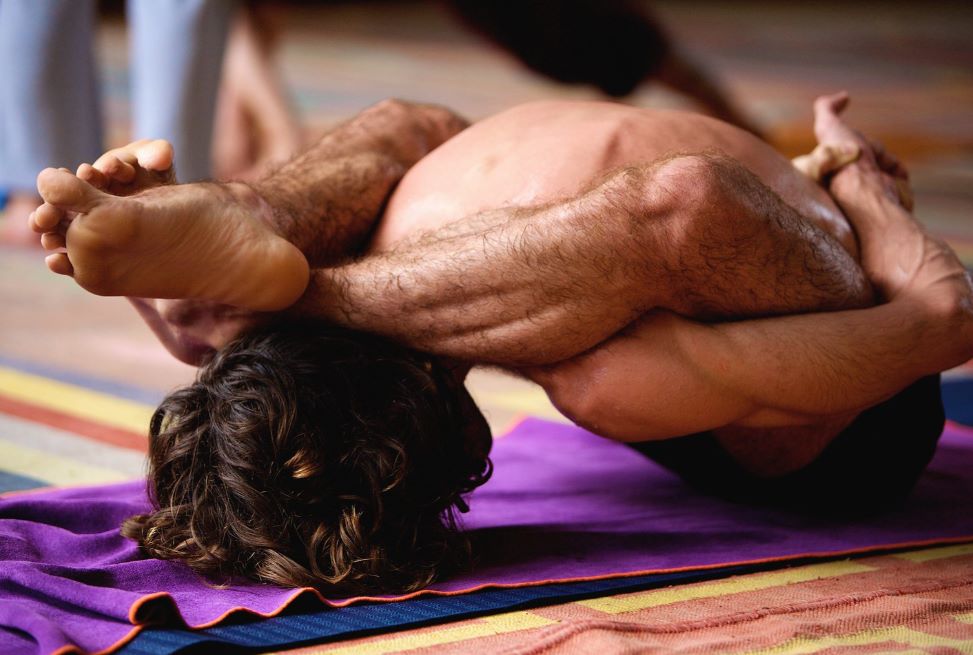
Supta Kurmasana is a more advanced variation where the legs are crossed behind the head. The body is folded forward with arms extended behind. This pose intensifies the stretch, requiring greater flexibility and core strength.
2. Ardha Kurmasana (Half Tortoise Pose)
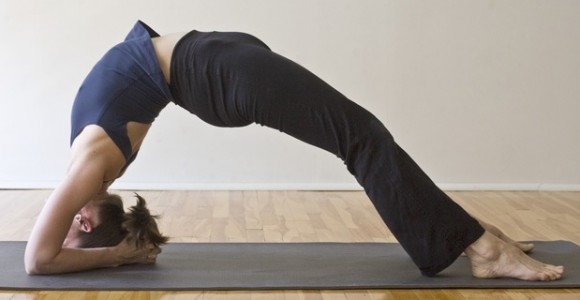
Ardha Kurmasana is a gentler variation where the forehead touches the ground, and the arms extend forward. This pose is more accessible, focusing on stretching the back and shoulders while promoting relaxation.
Things to Know Before Doing Kurmasana Yoga
Kurmasana is a deep forward bend that offers numerous physical and mental benefits. Understanding the essentials before practising Kurmasana can enhance your experience and prevent injuries. Here are important things to know before you begin.
- Warm-Up Exercises: Before attempting Kurmasana, it's crucial to warm up your body. Engage in dynamic stretches and gentle yoga poses to prepare your muscles and joints. Warming up reduces the risk of injury and improves flexibility.
- Proper Alignment: Maintaining proper alignment in Kurmasana is essential to prevent strain. Focus on keeping your spine long and your shoulders relaxed. Correct alignment enhances the effectiveness of the pose and ensures safety.
- Gradual Progression: Kurmasana is an advanced pose that requires flexibility and strength. Begin with simpler forward bends and gradually progress to deeper variations. Take your time to develop the necessary skills before attempting the full pose.
- Use of Props: Using props like bolsters, blocks, or straps can help you achieve the pose safely. Props provide support and assist in maintaining proper alignment. They are especially useful for beginners or those with limited flexibility.
- Breath Control: Incorporating proper breath control, or pranayama, is vital during Kurmasana. Deep, controlled breathing helps relax the muscles and deepen the stretch. It also enhances the meditative aspect of the pose.
- Listening to Your Body: Pay attention to your body’s signals and avoid pushing beyond your limits. Discomfort is natural, but sharp pain is a sign to stop. Respecting your body's boundaries prevents injuries and promotes a safe practice.
- Health Considerations: Individuals with certain health conditions should avoid or modify Kurmasana. Consult with a healthcare professional or a certified yoga instructor if you have back issues, hip problems, or other medical concerns.
- Mental Preparation: Kurmasana requires mental focus and patience. Prepare yourself mentally for the challenge by practising mindfulness and staying present. A calm mind enhances physical practice and helps you achieve the pose more effectively.
- Post-Practice Care: After practising Kurmasana, it’s important to cool down and stretch gently. Incorporate counter poses to release any tension in the back and hips. Post-practice care helps in preventing stiffness and aids in recovery.
How Long to Sit in Kurmasana?
The duration you should sit in Kurmasana can vary depending on your experience level and comfort. It's essential to listen to your body and gradually increase the duration as you become more proficient.
- Beginners: For beginners, it’s important to approach Kurmasana with caution and build up gradually. Start by holding the pose for 10 to 30 seconds. Focus on proper alignment and breath control, ensuring you do not strain your muscles.
- Intermediate Practitioners: Once you are more comfortable with the basics, you can extend your stay in Kurmasana to 30 seconds to 1 minute. At this level, your flexibility and strength will have improved, allowing you to deepen the pose.
- Advanced Practitioners: Advanced practitioners can hold Kurmasana for 1 to 3 minutes. At this stage, you should be able to maintain the pose with greater ease and stability. Holding the pose longer allows for a deeper stretch.
Beginners should start with shorter durations and gradually increase as their flexibility and strength improve. Intermediate practitioners can aim for up to a minute, while advanced yogis can hold the pose for several minutes.
Risks of Overdoing Kurmasana
While it offers numerous benefits, overdoing this pose can lead to various physical issues. Understanding the risks associated with the excessive practice of Kurmasana can help you approach it safely and mindfully. Here are some potential risks:
- Muscle Strain: Overextending muscles in Kurmasana can lead to strains, especially in the back, shoulders, and hamstrings. This can cause discomfort, pain, and limited mobility, requiring significant recovery time.
- Joint Injury: Forcing your body into a deeper stretch than it is ready for can strain joints, particularly in the hips and knees. This can lead to inflammation, pain, and potential long-term damage if not addressed promptly.
- Nerve Compression: Holding Kurmasana for too long or pushing too hard can compress nerves, leading to numbness, tingling, or pain. This is particularly common in the arms and legs, where the pose creates significant pressure.
- Lower Back Pain: Kurmasana involves a deep forward bend, which can put undue stress on the lower back if not performed correctly. Overdoing the pose can exacerbate existing back issues or create new problems, such as herniated discs.
- Hip Flexor Injury: The intense stretch of Kurmasana can strain the hip flexors, leading to pain and reduced flexibility. Overstretching these muscles can result in a tear, requiring extensive rest and rehabilitation.
- Breathing Difficulties: Holding Kurmasana for an extended period can restrict the chest and diaphragm, making it difficult to breathe deeply. This can lead to feelings of discomfort, dizziness, or even panic in some practitioners.
- Reduced Circulation: Staying in Kurmasana for too long can impede blood flow, particularly in the legs and arms. This can cause numbness, tingling, or cold extremities, and can be harmful if not addressed.
- Alignment Issues: Overemphasis on achieving the full expression of Kurmasana can lead to compromised alignment. This can result in poor posture and increase the risk of injury in other activities or poses.
While Kurmasana is a beneficial pose, it is crucial to approach it with caution and awareness. To avoid these risks, listen to your body, practice proper alignment, and gradually increase the intensity and duration of your practice.
Important Tips for Practising Kurmasana
For beginners, here are some tips you can check out if you want to practise the Tortoise Pose:
- Access a Professional Guide: Since this yoga posture is difficult, it is recommended to have a professional guide before trying this by yourself.
- Perform a Warm-Up Session: Make sure to perform a proper warm-up session to relax your muscles. You can also try practising the preparatory poses.
- Do Not Overstretch: You should be mindful while stretching your body; never over-stretch.
- Quit When Feeling Dizzy: If you feel uncomfortable or find yourself in pain or dizziness, you must stop doing this asana.
- Straighten the Legs: Sometimes your knees may feel stiff while you are in this posture. To avoid any muscle pull, straighten your legs slowly.
- Return to Normal Position Gently: When you return to the sitting posture, you should do it carefully. If you release your body at once, you may get a sprain.
- Do Some Follow-Up Exercises: After releasing your body, practice some of the follow-up poses.
What are the Precautions and Contraindications of Kurmasana?
As you know the steps to perform the Kurmasana, here are some safety precautions and contraindications you should adhere to while doing this posture:
When you are in the posture and experience extensive pain, gradually release and return to the first position.
If you have been through any surgery, refrain from doing this asana, as it may instigate pain. It is advisable to consult your doctor in such a situation.
If it is difficult for you to sit due to sciatica, it is better to avoid this posture as it can harm your legs.
For pregnant women, it is always advisable to consult their gynaecologist before doing any such extensive yoga postures.
People with certain health conditions like herniated discs, arthritis, fever, and severe stress must consult their doctors.
Who Should Avoid Doing Kurmasana?
Kurmasana is a challenging yoga posture that offers numerous benefits. However, it may only be suitable for some due to its intense nature. Here are some groups of people who should avoid practising Kurmasana, along with the reasons:
- People with Respiratory Issues: Those with respiratory problems, such as asthma, may find Kurmasana challenging due to the constriction of the chest. This can make breathing difficult and uncomfortable.
- Those with Abdominal Surgeries: Individuals who have recently undergone abdominal surgery should avoid Kurmasana. The deep compression of the abdomen can interfere with the healing process and cause complications.
- Individuals with Shoulder Injuries: People with shoulder injuries or conditions like rotator cuff tears should avoid this pose. The extension of the arms under the legs can place undue stress on the shoulders, risking further injury.
- Those with Knee Problems: Kurmasana involves a deep bend that can strain the knees. People with knee issues, such as ligament injuries or arthritis, may find this pose painful and potentially harmful.
- Pregnant Women: Pregnant women, especially those in the second and third trimesters, should avoid Kurmasana. The pose puts significant pressure on the abdomen, which can be harmful to both the mother and the developing fetus.
While Kurmasana is beneficial for health, it is not recommended for all patients. The best thing you can do is to have a health insurance plan that will cover the cost of the treatment in case any medical emergency arises. This way, you don't have to worry about your expenses and perform Kurmasana once you get fit.
What are the Easy Modifications of Kurmasana?
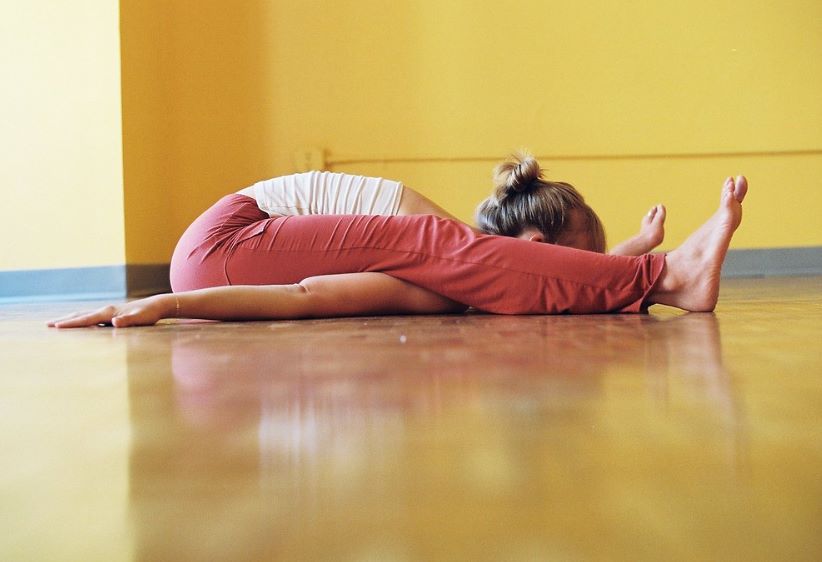
Kurmasana can be challenging for some, especially if you are just beginning to do yoga. Following are some easy modifications of the same pose that may help you attain the ultimate posture:
- Bend Your Knees: For every beginner who cannot do the full posture, they can bend their knees and keep their head above the ground.
- Keep Your Feet Together: Instead of stretching your legs, keep them together and bend your knees. This is a good starting point, as your inner thighs will get stretched here.
- Use Yoga Blocks: You can use blocks to support your chest rather than leaning completely on your chest.
There are both physical and mental benefits of Kurmasana. This restorative posture can help you connect your mind and body and cure several health conditions. So, when you consider adding this posture to your routine, make sure you follow and incorporate the information mentioned above.










